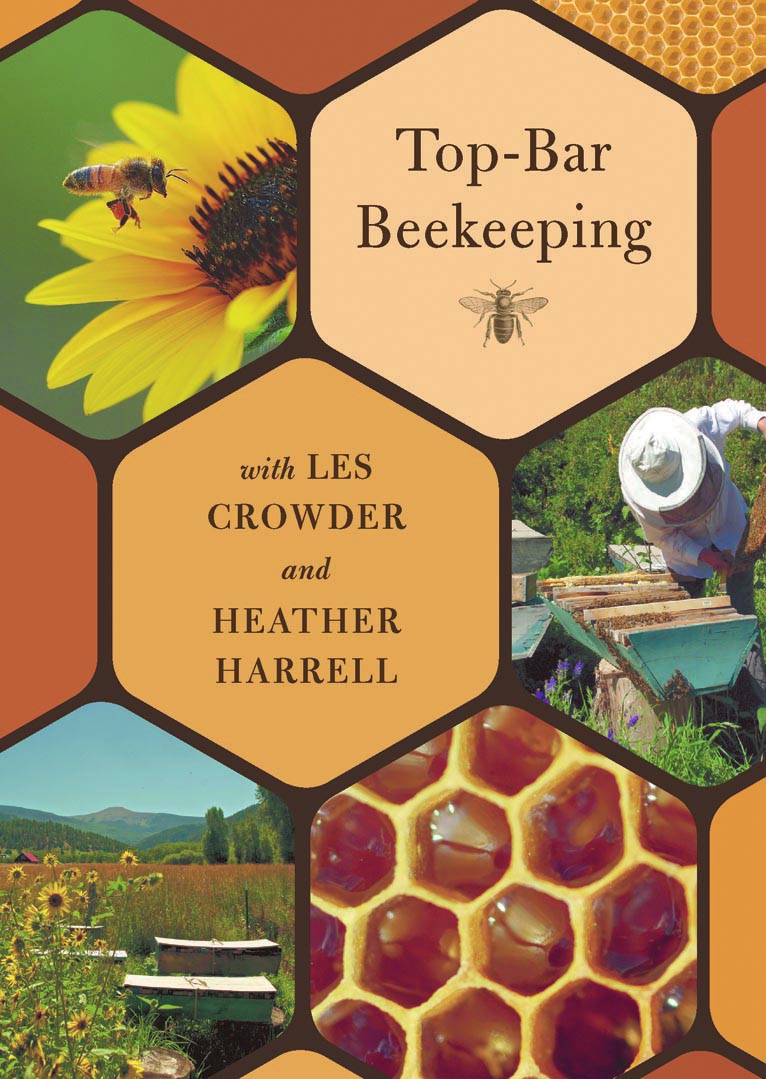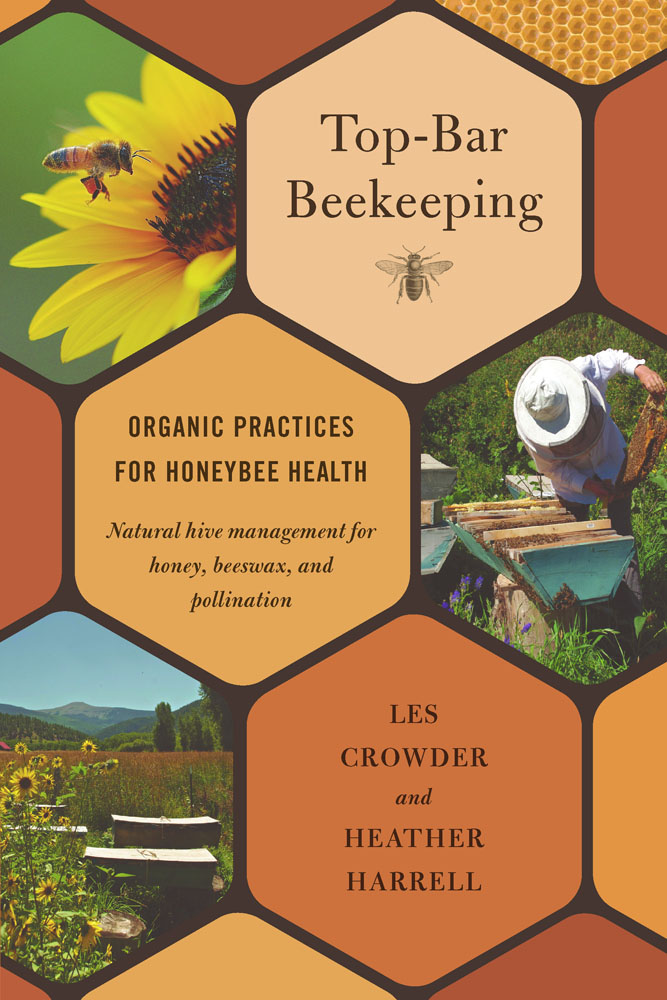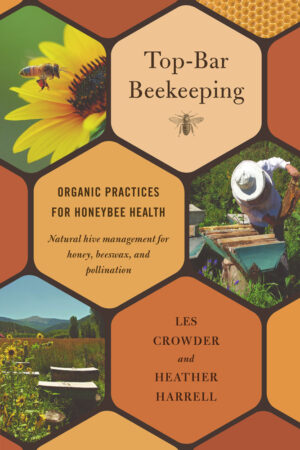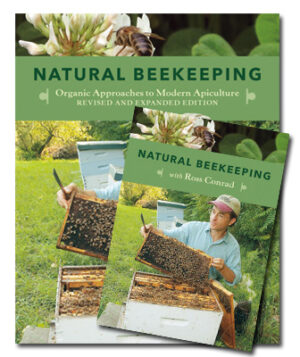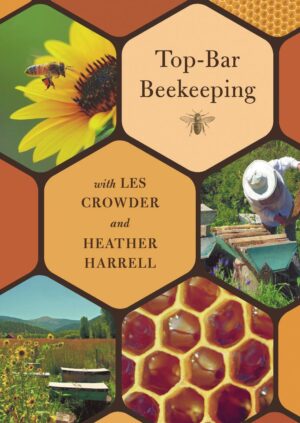| Playtime: | 50 minutes |
| Size: | 5.25 x 7.5 inch |
| Publisher: | Chelsea Green Publishing |
| Pub. Date: | December 1, 2012 |
| ISBN: | 9781603584807 |
Also available in:
Top-Bar Beekeeping with Les Crowder and Heather Harrell (DVD)
DVD
Original price was: $14.95.$7.47Current price is: $7.47.
In backyards and on rooftops all over the world, the top-bar hive design is revolutionizing the art and practice of beekeeping. With top-bar hives the bees naturally construct their own wax combs rather than relying on prefabricated frames of plastic cell foundation in a typical box-type hive. And top-bar hives are now being used to raise healthy bees organically, without the use of antibiotics, miticides, or other chemical inputs.
In this instructive video, New Mexico beekeeper Les Crowder shares his thirty years’ experience in developing best practices for working with bees in top-bar hives. Les and Heather Harrell, authors of Top-Bar Beekeeping (Chelsea Green, 2012) discuss everything from hive management techniques to how to harvest and process honey and beeswax to the best plants to grow for the foraging bees.
The natural, low-stress methods outlined in this video are perfect for home or hobbyist beekeepers who have the time and interest that’s necessary to manage bees intensively and holistically. The material will also be valuable for home orchardists, gardeners, and permaculture practitioners who are interested in bees as pollinators, as well as for their honey and beeswax.
Reviews and Praise
Library Journal-
"Top-Bar Beekeeping shares New Mexico beekeeper Crowder’s best practices gleaned from 30 years’ experience working organically with top-bar hives, the one-story frameless hives in which bees build combs downward from horizontal wooden bars at the top of the structure. Top-bar hives are a less expensive way to get started in beekeeping. The video shows methods for establishing bees in such hives, managing bees and combs, and harvesting honey and wax, plus natural methods of pest control and planting forage crops for healthy bees. VERDICT These two outstanding videos for those interested in exploring beekeeping were inspired by same-titled print works by the beekeepers and are highly recommended for general audiences." (reviewed with Natural Beekeeping)
More Reviews and Praise
ForeWord Review-
Farmers who seek a guide to hive maintenance told through a thoughtful personal narrative will benefit from the discussion of this topbar style of beekeeping. The first-person style of the book allows a window into the practices of the topbar beekeeper while conveying a wealth of knowledge and a well-researched comparison of hive practices. The book is appropriate for beginning beekeepers as well as those experienced but looking for information on natural and organic beekeeping practices.
The book’s ten sections discuss optimal practices of an organic beekeeper juxtaposed with discussion of industry standard practices and their drawbacks. Each section contains stories of the authors’ successes and failures as well as diagrams and pictures to explain everything from hive design to plant species for optimal pollination.
Chapter 2, “The Supercreature,” contains a thorough discussion of the social and industrial structure of a bee colony for farmers inexperienced with keeping a hive. The following section, “Beekeeping Basics,” discusses issues such as being stung, placing a hive, and trapping a swarm of bees for commercial use. The authors’ familiar voices elevate the book from a simple how-to manual to a memoir of common mistakes and earned victories in the beekeeping process.
In “The Seasons,” section, Crowder and Harrell deal with diverse problems in an accessible way. The chapter provides succinct answers to common questions that beekeepers would have. When contemplating dividing a hive, they suggest: “Ideally, the queen would be moved to a new yard altogether, but this is not absolutely essential.” In addition to dealing with times of the year, the chapter addresses a common pest for hives: bears. “It is important to set up the bear fence first.,” advise the authors. “It is inconsiderate to bees and bears to leave bees unprotected in bear territory.”
Whether the reader is looking to start their own hive or simply increase their knowledge of honeybees, the book provides interesting and detailed discussions of all aspects of raising them. Crowder and Harrell offer not only advice on how to get started, but an in-depth discussion of all aspects of keeping a hive, from bee capture, breeding, and selection to honey processing. They have crafted a book that is both informative and engaging, filled with introspective advice and practical knowledge.
Publishers Weekly Review-
Cave drawings show beekeepers “smoking” their hives, preparing for insect interaction. Today’s mass-produced honey relies mostly on the venerable Langstroth method of beekeeping, which has produced plenty of honey—but also has introduced plenty of chemicals into the process—through the years. Top-bar hives, named for the bars that run across their tops, are popular with bee beginners even though they produce less honey than Langstroth hives. But this account, the culmination of Crowder and Harrell’s 40 years of top-bar beekeeping adventures, shows the reader their method’s advantages: it avoids antibiotics, miticides, and other chemicals inherent to the conventional process. Crowder and his wife, Harrell, leave no comb unharvested as they take the top-bar aspirant from bee basics (stings, smoke, and hive transfers) through hive management (comb removal and feeding) to beneficial, and profitable, byproducts like beeswax. For those a bit lukewarm to the swarm, the book gives a fascinating insight into bees’ elaborate organizational and geometry skills, and it may even make one reconsider buying mass-marketed, chemical-laced honey.
Reviews and Praise
Library Journal-
"Top-Bar Beekeeping shares New Mexico beekeeper Crowder’s best practices gleaned from 30 years’ experience working organically with top-bar hives, the one-story frameless hives in which bees build combs downward from horizontal wooden bars at the top of the structure. Top-bar hives are a less expensive way to get started in beekeeping. The video shows methods for establishing bees in such hives, managing bees and combs, and harvesting honey and wax, plus natural methods of pest control and planting forage crops for healthy bees. VERDICT These two outstanding videos for those interested in exploring beekeeping were inspired by same-titled print works by the beekeepers and are highly recommended for general audiences." (reviewed with Natural Beekeeping)
ForeWord Review-
Farmers who seek a guide to hive maintenance told through a thoughtful personal narrative will benefit from the discussion of this topbar style of beekeeping. The first-person style of the book allows a window into the practices of the topbar beekeeper while conveying a wealth of knowledge and a well-researched comparison of hive practices. The book is appropriate for beginning beekeepers as well as those experienced but looking for information on natural and organic beekeeping practices.
The book’s ten sections discuss optimal practices of an organic beekeeper juxtaposed with discussion of industry standard practices and their drawbacks. Each section contains stories of the authors’ successes and failures as well as diagrams and pictures to explain everything from hive design to plant species for optimal pollination.
Chapter 2, “The Supercreature,” contains a thorough discussion of the social and industrial structure of a bee colony for farmers inexperienced with keeping a hive. The following section, “Beekeeping Basics,” discusses issues such as being stung, placing a hive, and trapping a swarm of bees for commercial use. The authors’ familiar voices elevate the book from a simple how-to manual to a memoir of common mistakes and earned victories in the beekeeping process.
In “The Seasons,” section, Crowder and Harrell deal with diverse problems in an accessible way. The chapter provides succinct answers to common questions that beekeepers would have. When contemplating dividing a hive, they suggest: “Ideally, the queen would be moved to a new yard altogether, but this is not absolutely essential.” In addition to dealing with times of the year, the chapter addresses a common pest for hives: bears. “It is important to set up the bear fence first.,” advise the authors. “It is inconsiderate to bees and bears to leave bees unprotected in bear territory.”
Whether the reader is looking to start their own hive or simply increase their knowledge of honeybees, the book provides interesting and detailed discussions of all aspects of raising them. Crowder and Harrell offer not only advice on how to get started, but an in-depth discussion of all aspects of keeping a hive, from bee capture, breeding, and selection to honey processing. They have crafted a book that is both informative and engaging, filled with introspective advice and practical knowledge.
Publishers Weekly Review-
Cave drawings show beekeepers “smoking” their hives, preparing for insect interaction. Today’s mass-produced honey relies mostly on the venerable Langstroth method of beekeeping, which has produced plenty of honey—but also has introduced plenty of chemicals into the process—through the years. Top-bar hives, named for the bars that run across their tops, are popular with bee beginners even though they produce less honey than Langstroth hives. But this account, the culmination of Crowder and Harrell’s 40 years of top-bar beekeeping adventures, shows the reader their method’s advantages: it avoids antibiotics, miticides, and other chemicals inherent to the conventional process. Crowder and his wife, Harrell, leave no comb unharvested as they take the top-bar aspirant from bee basics (stings, smoke, and hive transfers) through hive management (comb removal and feeding) to beneficial, and profitable, byproducts like beeswax. For those a bit lukewarm to the swarm, the book gives a fascinating insight into bees’ elaborate organizational and geometry skills, and it may even make one reconsider buying mass-marketed, chemical-laced honey.

